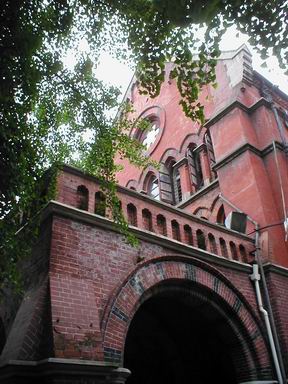 Almost as soon as we got off the plane on Wednesday, Rosemary (my mum) dragged me from the tourist trap of the Bund, into some overcrowded, grimy backstreets hunting for the derelict cathedral where her parents were married and she was christened. The magnetic levitation train from Pudong Airport was great fun – not because it travelled at 431 km/h, the fastest train in the world, but because at some points the earth around us seemed to rotate at what felt like, but could not have been, an unnerving 45 degrees. It turned out that we were tilting, but so exactly as we cornered that you couldn’t feel any force.
Almost as soon as we got off the plane on Wednesday, Rosemary (my mum) dragged me from the tourist trap of the Bund, into some overcrowded, grimy backstreets hunting for the derelict cathedral where her parents were married and she was christened. The magnetic levitation train from Pudong Airport was great fun – not because it travelled at 431 km/h, the fastest train in the world, but because at some points the earth around us seemed to rotate at what felt like, but could not have been, an unnerving 45 degrees. It turned out that we were tilting, but so exactly as we cornered that you couldn’t feel any force.
In 1842, shortly after a war about opium (which sounds too inocuous, let’s just call it heroin but with fewer laboratories), the British and other western countries gained effective territorial control over parts of China. In 1923, short of work, my grandfather came from Dublin to Shanghai by slow boat to work as a chemist for Shanghai Municpal Council. In 1930, short of adventure, my grandmother flitted through Canada and Japan before settling in Shanghai to teach Physical Education at Thomas Hanbury Public School, just north of Soochow creek. There’s a love story here, but I’ll tell that another time (probably if I ever catch the trans-Siberian express).
We found the cathedral, where they later married, in a pretty bad state, which upset Rosemary (the photo, right, sets it off in a good light, so as not to distress too much). There were small trees growing out of the brickwork, and junk piled up in the entrance. Buildings and walls set closely round it, ruining the grand space it occupied originally. The guard was friendly and let us poke about, we’ve found them much less hostile than Rosemary did 24 years ago when she was last here. There was a posh Chinese language Christian bookshop near the entrance, and the junk turned out to be for renovation work.
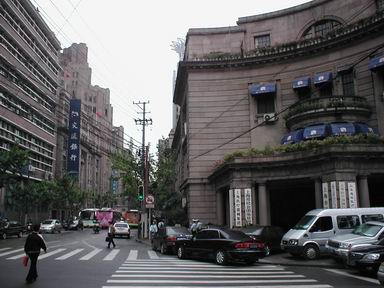 We also found the old council building (photo left), and nosed inside. It’s lucky that the guards are friendly now, as it seems Rosemary won’t let any fear stop her from access to family history. It was grand inside, and there were lots of old framed photos of the building under construction, and of speeches from the balcony (see photo) to celebrate when the Communists took over rule of the city in 1949. My grandfather worked in here. He did lots of different things, mainly to do with water pollution, but also, for example, helping to develop tarmac suitable for the local weather.
We also found the old council building (photo left), and nosed inside. It’s lucky that the guards are friendly now, as it seems Rosemary won’t let any fear stop her from access to family history. It was grand inside, and there were lots of old framed photos of the building under construction, and of speeches from the balcony (see photo) to celebrate when the Communists took over rule of the city in 1949. My grandfather worked in here. He did lots of different things, mainly to do with water pollution, but also, for example, helping to develop tarmac suitable for the local weather.
Everyone puts their own interpretation on places. To the signs made by the government, everywhere is a Communist memorial – where the first party congress was, how much they are doing to clear up the environment. To my mum, everything is the old Shanghailander in her – architecture from a grand age, bridges that Japanese soldiers marched them over, streets where her mother used to shop. I’ll give my take on Shanghai in another post.
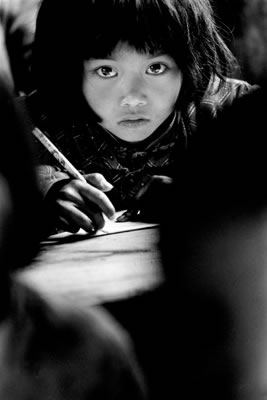 A week on Tuesday I’m going to China again. Starting in Shanghai, which is on the East coast in the centre, at the mouth of the Yangtze river. I’m travelling with Rosemary, my mum (who I spent a few weeks with in Japan three years ago; see the last few articles
A week on Tuesday I’m going to China again. Starting in Shanghai, which is on the East coast in the centre, at the mouth of the Yangtze river. I’m travelling with Rosemary, my mum (who I spent a few weeks with in Japan three years ago; see the last few articles 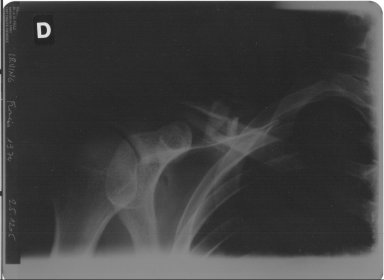 A Frenchman came and asked me if I wanted a doctor (luckily basic French doesn’t disappear with injury). I thought I was just winded, but then realised I couldn’t lift up my arm. He kindly gave me a lift to the surgery and an efficient medical system filled me with morphine and gave me a sling. (Paid for later via the
A Frenchman came and asked me if I wanted a doctor (luckily basic French doesn’t disappear with injury). I thought I was just winded, but then realised I couldn’t lift up my arm. He kindly gave me a lift to the surgery and an efficient medical system filled me with morphine and gave me a sling. (Paid for later via the 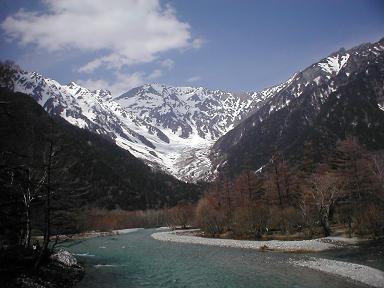 When I was a child there was only one thing considered more dangerous than taking sweets off strangers. It’s so ingrained in me by the ambient protection of society not to hitch hike that I have never even considered doing it. All sorts of unclarified bad things might happen. For example, people might have conversations with other people that they didn’t know already, or (gasp!) who belong to a different social class. Perhaps, like in China, people might learn to start paying each other for lifts, thus creating a more efficient and more capitalist transport economy, with the added side effect of being better for the environment. The consequences both for society, and in increasing everyones standard of living, could have no end of positive implications.
When I was a child there was only one thing considered more dangerous than taking sweets off strangers. It’s so ingrained in me by the ambient protection of society not to hitch hike that I have never even considered doing it. All sorts of unclarified bad things might happen. For example, people might have conversations with other people that they didn’t know already, or (gasp!) who belong to a different social class. Perhaps, like in China, people might learn to start paying each other for lifts, thus creating a more efficient and more capitalist transport economy, with the added side effect of being better for the environment. The consequences both for society, and in increasing everyones standard of living, could have no end of positive implications.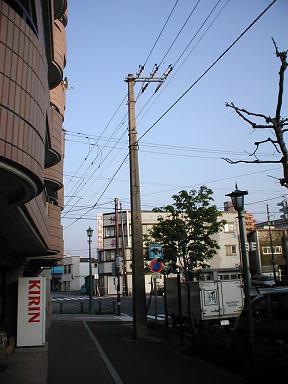 Now I can finally reveal the goal of all my travelling, the destination which I’ve been striving for all these long, last five months. In Hakodate at the end of last week Rosemary and I finally made it to this technological mecca. For you to fully understand I will first explain some background.
Now I can finally reveal the goal of all my travelling, the destination which I’ve been striving for all these long, last five months. In Hakodate at the end of last week Rosemary and I finally made it to this technological mecca. For you to fully understand I will first explain some background.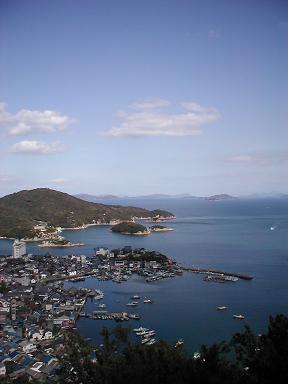 Japan has a sea with no waves, where only narrow connections to the vast Pacific add salt and stop us calling it a lake. It’s an enchanting place, the distinctive shape of the islands a familiar romantic myth from much Japanese art. Rosemary and I spent much of last week travelling from Kansai along the north coast of the sea to Hiroshima and back. This picture is taken from a hillside temple at the fishing port of Tomo no Ura; it gives a good feel for the dramatic but cosy views across the sea in the sun. Even better was the Sete Ohashi bridge which we crossed on a day trip to Takamatsu. It was a dreadful foggy day, and all we could see from the train was white mist with peaks of the islands coming in and out of view. Only seeing the tops made them all the more mystical in shape.
Japan has a sea with no waves, where only narrow connections to the vast Pacific add salt and stop us calling it a lake. It’s an enchanting place, the distinctive shape of the islands a familiar romantic myth from much Japanese art. Rosemary and I spent much of last week travelling from Kansai along the north coast of the sea to Hiroshima and back. This picture is taken from a hillside temple at the fishing port of Tomo no Ura; it gives a good feel for the dramatic but cosy views across the sea in the sun. Even better was the Sete Ohashi bridge which we crossed on a day trip to Takamatsu. It was a dreadful foggy day, and all we could see from the train was white mist with peaks of the islands coming in and out of view. Only seeing the tops made them all the more mystical in shape.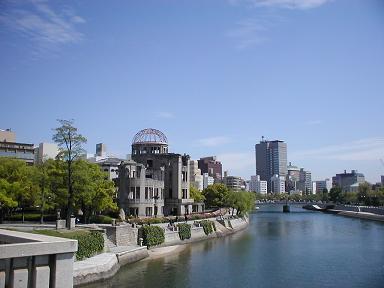 The politcally correct question to debate at this point is whether the US was justified in using it. This is besides the point – the functioning of the war machine of a country made its use inevitable. One argument goes that ending the war quickly and with less total loss of life was the motive, but I feel that was just a side issue. More important was to test this new device in real action, and to show the world just how strong the US had become. Would any functioning military, a structure by its very nature designed to kill, surprise, shock and awe, really have missed this opportunity? Was the
The politcally correct question to debate at this point is whether the US was justified in using it. This is besides the point – the functioning of the war machine of a country made its use inevitable. One argument goes that ending the war quickly and with less total loss of life was the motive, but I feel that was just a side issue. More important was to test this new device in real action, and to show the world just how strong the US had become. Would any functioning military, a structure by its very nature designed to kill, surprise, shock and awe, really have missed this opportunity? Was the